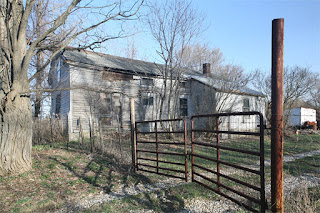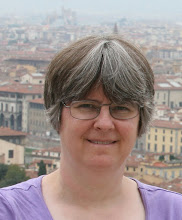More photoshop fun
.jpg) Here's that "interesting old dilapidated farmhouse" I mentioned in my last post. The photo I'd taken of it seemed pretty good to me at first glance (apart from the vignetting in the upper right corner), even after having stared at it for a long time. But that was before I "met" Julianne Kost. I've been watching her DVD tutorials on Photoshop, and I had no idea how much better you could make an already pretty good photo. Today I learned how to fix lens distortion and change perspective. I wasn't even able to recognize lens distortion before I watched this video. After watching it, the distortion jumped right out at me in my original image. The photo was taken with a 24mm lens, which is a somewhat wide angle. The wider the angle, the more distortion (towards the "fish-eye" look of ultra-wide angle lenses) you will get. It's barely perceptible at 24mm unless you know what you're looking for. You might have to click the image to see an enlarged version to be able to see it. Notice how the rusty post to the right is sort of bowed as it bulges out towards you away from the center of the photo? That's lens distortion...well, one kind anyway.
Here's that "interesting old dilapidated farmhouse" I mentioned in my last post. The photo I'd taken of it seemed pretty good to me at first glance (apart from the vignetting in the upper right corner), even after having stared at it for a long time. But that was before I "met" Julianne Kost. I've been watching her DVD tutorials on Photoshop, and I had no idea how much better you could make an already pretty good photo. Today I learned how to fix lens distortion and change perspective. I wasn't even able to recognize lens distortion before I watched this video. After watching it, the distortion jumped right out at me in my original image. The photo was taken with a 24mm lens, which is a somewhat wide angle. The wider the angle, the more distortion (towards the "fish-eye" look of ultra-wide angle lenses) you will get. It's barely perceptible at 24mm unless you know what you're looking for. You might have to click the image to see an enlarged version to be able to see it. Notice how the rusty post to the right is sort of bowed as it bulges out towards you away from the center of the photo? That's lens distortion...well, one kind anyway..jpg) Now look at the photo again after I did some touching up in Photoshop. The post is straight. The perspective on the house looks a bit more natural (not all of that tilt in it before was due to the fact that the house really is collapsing!). I also got rid of the "vignetting" (the darkening in the corners) which is another lens artifact. I probably had too many filters on my lens, and the wide angle lens will pick up a bit of the black rim of the filters in that case. Normally your camera will correct for the fact that the lens opening is round and the frame is rectangular, but in some situations it's not perfect.
Now look at the photo again after I did some touching up in Photoshop. The post is straight. The perspective on the house looks a bit more natural (not all of that tilt in it before was due to the fact that the house really is collapsing!). I also got rid of the "vignetting" (the darkening in the corners) which is another lens artifact. I probably had too many filters on my lens, and the wide angle lens will pick up a bit of the black rim of the filters in that case. Normally your camera will correct for the fact that the lens opening is round and the frame is rectangular, but in some situations it's not perfect.
I don't know what it is about falling apart buildings, but I really like to photograph them. See this other one I did.



No comments:
Post a Comment